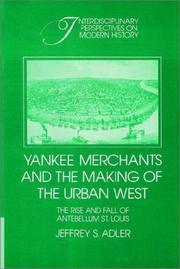| Listing 1 - 2 of 2 |
Sort by
|
Book
ISBN: 9781107706453 9781107068988 9781107667518 9781316074381 1316074382 1107706459 9781316079126 1316079120 1107068983 1107667518 1316055477 1316083845 1316057844 1316081486 1316072029 131607675X Year: 2014 Publisher: Cambridge Cambridge University Press
Abstract | Keywords | Export | Availability | Bookmark
 Loading...
Loading...Choose an application
- Reference Manager
- EndNote
- RefWorks (Direct export to RefWorks)
The sectional conflict over slavery in the United States was not only a clash between labour systems and political ideologies but also a viscerally felt part of the lives of antebellum Americans. This book contributes to the growing field of emotions history by exploring how specific emotions shaped Americans' perceptions of, and responses to, the sectional conflict in order to explain why it culminated in disunion and war. Emotions from indignation to jealousy were inextricably embedded in antebellum understandings of morality, citizenship, and political affiliation. Their arousal in the context of political debates encouraged Northerners and Southerners alike to identify with antagonistic sectional communities and to view the conflicts between them as worth fighting over. Michael E. Woods synthesizes two schools of thought on Civil War causation: the fundamentalist, which foregrounds deep-rooted economic, cultural, and political conflict, and the revisionist, which stresses contingency, individual agency, and collective passion.
Slavery --- Social conflict --- Sectionalism (United States) --- Emotions --- Feelings --- Human emotions --- Passions --- Psychology --- Affect (Psychology) --- Affective neuroscience --- Apathy --- Pathognomy --- Class conflict --- Class struggle --- Conflict, Social --- Social tensions --- Interpersonal conflict --- Social psychology --- Sociology --- Abolition of slavery --- Antislavery --- Enslavement --- Mui tsai --- Ownership of slaves --- Servitude --- Slave keeping --- Slave system --- Slaveholding --- Thralldom --- Crimes against humanity --- Serfdom --- Slaveholders --- Slaves --- Political aspects --- History --- Social aspects --- United States --- Causes. --- Social conditions --- Politics and government --- Sectionalism (U.S.) --- Enslaved persons

ISBN: 0521412846 0521522358 0511523017 Year: 1991 Publisher: Cambridge : Cambridge University Press,
Abstract | Keywords | Export | Availability | Bookmark
 Loading...
Loading...Choose an application
- Reference Manager
- EndNote
- RefWorks (Direct export to RefWorks)
By the early 1850s, St Louis was one of the fastest-growing cities in America. In this book, Jeffrey Adler analyzes the forces that determined the role of western cities in the national economy. He devotes particular attention to the ways in which Yankee merchants forged ties that linked St Louis to the New York and Boston markets. Northeastern businessmen fuelled the ascent of St Louis and made the city a Yankee colony in the West. During the mid-1850s powerful political and cultural forces altered the sources of urban growth in the West. As a result, the economy of St Louis collapsed. Yankee merchants stopped migrating to the city and ceased investing in local businesses. This book demonstrates that the sectional crisis abruptly transformed St Louis's role in the national economy, redirecting the flow of capital and migrants away from St. Louis and toward a smaller western city - Chicago.
Saint Louis (Mo.) --- Economic conditions --- Commerce --- Sectionalism (United States) --- History --- Arts and Humanities --- Sectionalism (U.S.) --- History. --- Economic conditions. --- St. Louis (Mo.) --- St. Louis --- City of St. Louis (Mo.) --- Sent-Lüis (Mo.) --- Горад Сент-Луіс (Mo.) --- Horad Sent-Luis (Mo.) --- Сэнт-Луіс (Mo.) --- Сейнт Луис (Mo.) --- Seĭnt Luis (Mo.) --- San Luis (Mo.) --- San Luis de Iluenses (Mo.) --- Ciudad de San Luis (Mo.) --- Sankta Luiso (Mo.) --- סנט לואיס (Mo.) --- Sanṭ Luʼis (Mo.) --- Urbs Sancti Ludovici (Mo.) --- Sancti Ludovici (Mo.) --- Sentluisa (Mo.) --- Sent Luisas (Mo.) --- Сент Луис (Mo.) --- セントルイス (Mo.) --- Sentoruisu (Mo.) --- São Luís (Mo.) --- Сент-Луїс (Mo.) --- Sent Loisos (Mo.) --- 圣路易斯 (Mo.) --- Shengluyisi (Mo.) --- Sheng lu yi si (Mo.) --- Sheng Luyisi (Mo.) --- City of Saint Louis (Mo.) --- Lacledes Village (Mo.) --- Mound City (Mo.) --- Pain Court (Mo.) --- Pancore (Mo.) --- Saint Lewis (Mo.) --- Saint Louis City (Mo.) --- Rome of the West (Mo.) --- STL (Mo.) --- Gateway to the West (Mo.)
| Listing 1 - 2 of 2 |
Sort by
|

 Search
Search Feedback
Feedback About UniCat
About UniCat  Help
Help News
News